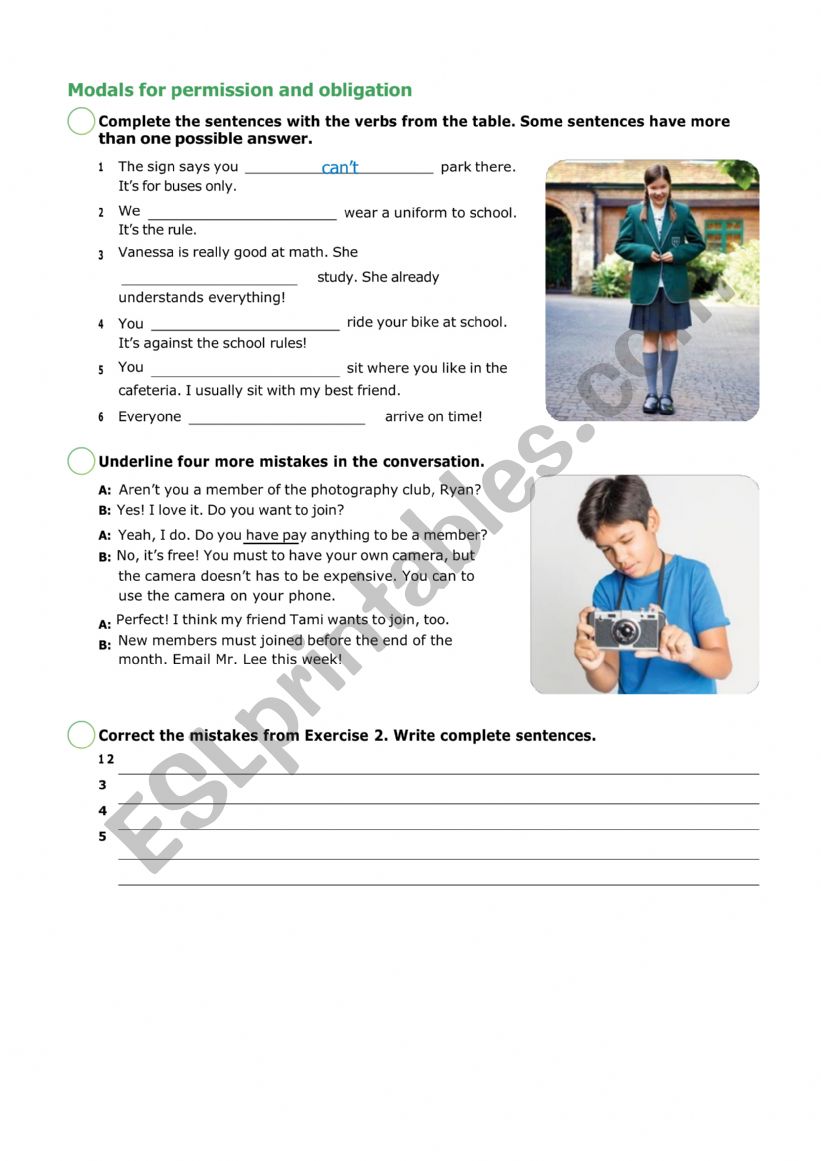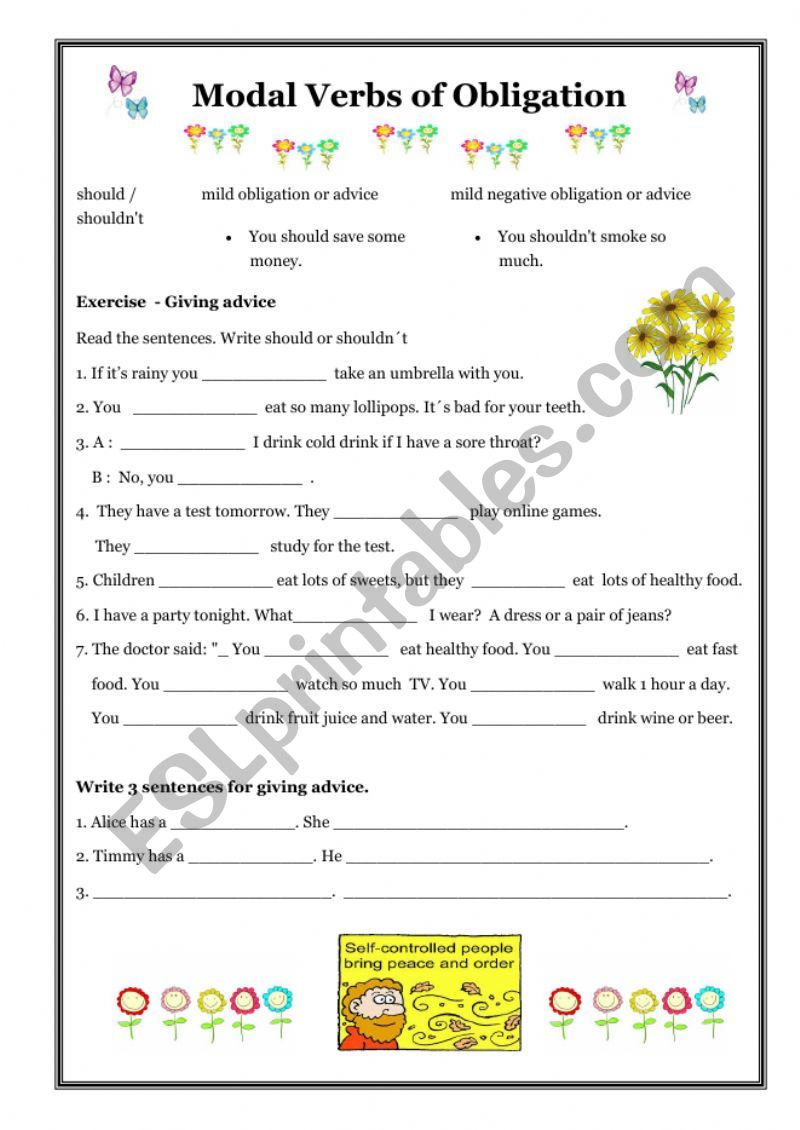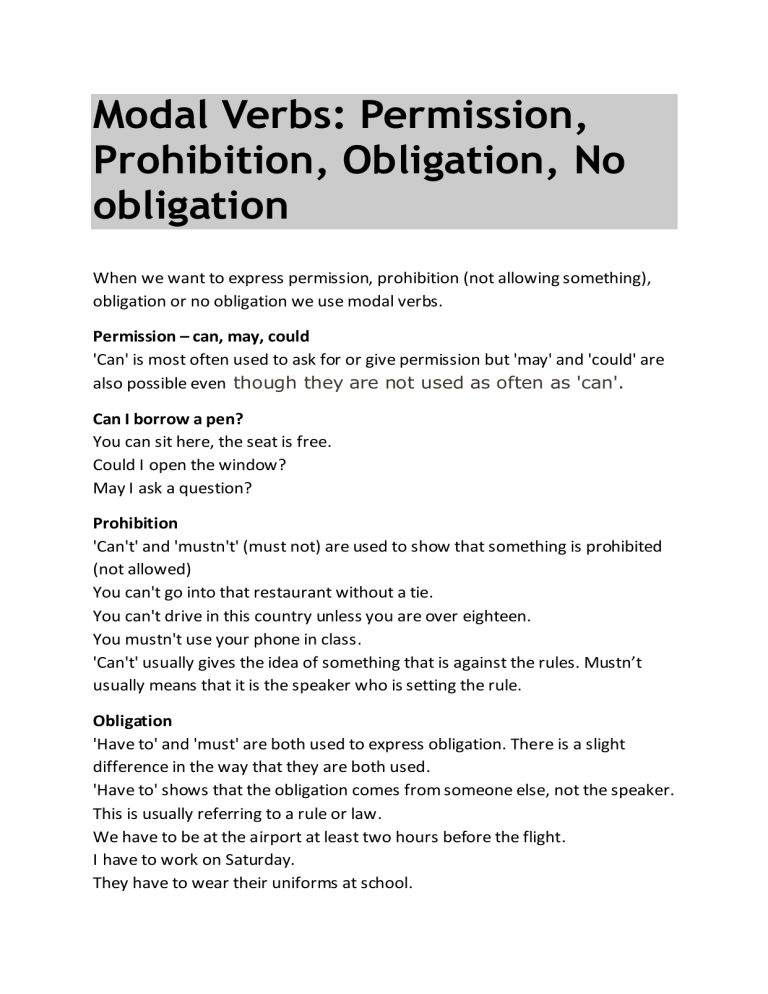
Mastering Nuance: The Indispensable Role of Modal Verbs of Obligation and Permission Worksheets
In the realm of English language education, few tools are as universally effective and perpetually relevant as Modal verbs of obligation and permission worksheets. These specialized resources are critical for learners across all proficiency levels, from beginners grappling with basic sentence structures to advanced students refining their understanding of subtle communicative nuances. Modal verbs – such as can, could, may, might, must, shall, should, will, would, ought to, and have to – are essential for conveying a wide range of meanings, including ability, possibility, advice, and crucially, obligation and permission. Without a solid grasp of these verbs, learners struggle to express necessities, rules, allowances, and prohibitions accurately, leading to miscommunication and a lack of fluency.
This article delves deep into the significance and multifaceted utility of Modal verbs of obligation and permission worksheets, exploring their design, implementation, and the diverse types available to educators and self-learners alike. We will examine why these worksheets are so vital, the specific modals they target, and how they can be leveraged to foster a comprehensive understanding and practical application of these crucial grammatical components.

Understanding Modal Verbs of Obligation and Permission

Before discussing the worksheets themselves, it’s vital to clarify the specific modal verbs related to obligation and permission:

1. Modals of Obligation: These verbs express necessity, duty, or strong recommendation.

- Must: Indicates a strong, often internal, obligation or a rule.
- Examples: "You must complete this assignment by Friday." (Strong obligation) "She must be exhausted after working all night." (Logical deduction, strong likelihood)
- Have to / Has to: Indicates an external obligation, often imposed by rules, laws, or circumstances.

- Examples: "We have to wear uniforms at school." (External rule) "He has to leave early because of an appointment." (Circumstantial necessity)

- Should / Ought to: Expresses a recommendation, advice, or a moral obligation. It’s less forceful than must or have to.

- Examples: "You should study for your exam." (Advice) "We ought to help those in need." (Moral obligation)

- Need to: Similar to have to, indicating necessity.
- Examples: "I need to buy groceries." (Necessity)
- Don’t have to / Doesn’t have to: Expresses a lack of obligation or necessity.
- Examples: "You don’t have to come if you’re busy." (No obligation)
- Mustn’t / Must not: Expresses prohibition or something that is not allowed. This is a strong negative obligation.
- Examples: "You mustn’t smoke in here." (Prohibition)

2. Modals of Permission: These verbs express allowance or the granting of consent.
- Can: The most common and versatile modal for expressing permission in informal contexts. It also expresses ability.
- Examples: "Can I use your pen?" (Asking permission) "You can leave now if you’re finished." (Granting permission)
- Could: A more polite or formal way to ask for permission than can. It also expresses past ability or possibility.
- Examples: "Could I borrow your car for a moment?" (Polite request)
- May: A more formal and traditional way to ask for or grant permission. It also expresses possibility.
- Examples: "May I come in?" (Formal request) "You may begin the test now." (Granting permission formally)
- Might: Expresses a very slight possibility of permission, or a hesitant suggestion. It is rarely used to grant permission directly.
- Examples: "You might be able to go if you finish your chores." (Conditional, slight permission)
- Can’t / Cannot: Expresses lack of permission or prohibition.
- Examples: "You can’t park here." (Prohibition)
- May not: A more formal way to express lack of permission or prohibition.
- Examples: "Students may not use their phones during the exam." (Formal prohibition)
The nuances between these verbs are subtle but significant. For instance, "You must come" implies a stronger, often internal, compulsion than "You have to come," which suggests an external rule or circumstance. Similarly, "May I come in?" is more formal than "Can I come in?". These distinctions are crucial for effective communication, and this is precisely where targeted practice with Modal verbs of obligation and permission worksheets becomes invaluable.
Why Worksheets Are Essential for Learning Modals
The enduring appeal of Modal verbs of obligation and permission worksheets lies in their direct application to learning objectives. They provide structured, repetitive practice that is necessary for internalizing complex grammatical rules. Here’s why they are so vital:
- Reinforcement of Concepts: After an initial explanation, worksheets offer the necessary practice to solidify understanding. Learners apply rules in various contexts, reinforcing what they’ve learned.
- Identification of Gaps: Through completing exercises, both learners and educators can identify specific areas of confusion or weakness. This allows for targeted review and additional instruction.
- Active Learning: Worksheets require active engagement, prompting learners to recall, analyze, and apply their knowledge rather than passively receiving information.
- Self-Paced Learning: Learners can work through worksheets at their own pace, reviewing sections as needed. This is particularly beneficial for diverse learning styles and abilities.
- Assessment Tool: Worksheets serve as an excellent informal assessment tool, allowing teachers to gauge student comprehension before formal tests.
- Contextualization: Good worksheets present modals within realistic sentences and scenarios, helping learners understand their practical usage beyond isolated rules.
- Variety of Exercise Types: The diverse formats of worksheets keep learning engaging and address different cognitive skills.
Types of Effective Modal Verbs of Obligation and Permission Worksheets
A well-rounded set of Modal verbs of obligation and permission worksheets will include a variety of exercise types to cater to different learning styles and target various aspects of language acquisition.
-
Gap-Fill Exercises:
- Description: Learners fill in blanks with the correct modal verb from a given list or based on context.
- Benefit: Excellent for initial practice, testing basic recall of meaning and form.
- Example: "You _____ wear a seatbelt when driving." (must/can’t/should)
-
Multiple Choice Questions:
- Description: Learners choose the best modal verb from a selection of options.
- Benefit: Helps learners differentiate between similar modals and their nuanced meanings.
- Example: "We _____ go to the party if we finish our homework. (a) must (b) may (c) don’t have to"
-
Sentence Transformation/Rewriting:
- Description: Learners rewrite sentences using a different modal verb while maintaining the original meaning, or transform positive sentences into negative/interrogative forms.
- Benefit: Develops flexibility in usage and understanding of different levels of obligation/permission.
- Example: "It is necessary for you to attend." → "You _____ attend."
-
Error Correction:
- Description: Learners identify and correct mistakes in sentences where modals are used incorrectly.
- Benefit: Encourages critical thinking and a deeper understanding of common errors.
- Example: "You mustn’t to smoke here." (Correction: "You mustn’t smoke here.")
-
Dialogue/Role-Play Prompts:
- Description: Worksheets provide scenarios or incomplete dialogues where learners must use appropriate modals to express obligation or permission.
- Benefit: Promotes communicative competence and helps learners practice modals in a realistic conversational context.
- Example: "Scenario: You are asking your boss for a day off. What would you say? (Use ‘may’ or ‘could’)."
-
Matching Exercises:
- Description: Learners match sentences with their corresponding modal verbs or match rules/situations with appropriate modal expressions.
- Benefit: Reinforces understanding of meaning and context.
- Example: Match: "You have to wear a helmet." with "It’s a rule/law."
-
Picture-Based Prompts:
- Description: Learners describe actions or rules in pictures using modal verbs.
- Benefit: Appeals to visual learners and encourages creative application of modals.
- Example: A picture of a "No Parking" sign prompts the sentence: "You mustn’t park here."
-
Open-Ended/Creative Writing:
- Description: Learners write short paragraphs, rules, or advice using a variety of modal verbs.
- Benefit: Encourages independent production and integrates modals into broader writing tasks.
- Example: "Write a short paragraph about the rules for students in your school, using must, have to, and can’t."
Designing and Implementing Effective Worksheets
For educators and self-learners, the quality of Modal verbs of obligation and permission worksheets directly impacts their effectiveness. Here are key considerations for design and implementation:
Design Principles:
- Clear Instructions: Ensure instructions are concise, unambiguous, and easy to understand.
- Gradual Difficulty: Start with simpler exercises (e.g., gap-fills) and progress to more complex ones (e.g., transformations, open-ended tasks).
- Contextualization: Present modals within meaningful sentences and realistic scenarios. Avoid isolated sentences that lack context.
- Relevance: Use examples that are relevant and interesting to the target learners.
- Variety: Incorporate different exercise types to keep learners engaged and address various learning skills.
- Visual Appeal: Use clear formatting, adequate spacing, and potentially images to make the worksheet inviting.
- Answer Key: For self-study, a comprehensive answer key is crucial for immediate feedback and correction.
Implementation Strategies:
- Pre-Teaching: Always introduce the modal verbs and their nuances thoroughly before assigning worksheets. Provide clear examples and explanations.
- Guided Practice: Begin by working through a few examples together as a class or reviewing the first few items in a self-study session to ensure understanding of the task.
- Independent Practice: Allow learners sufficient time to complete the worksheets independently.
- Feedback and Correction: Provide constructive feedback. For classroom settings, review answers together, discussing why certain modals are correct and others are not. For self-learners, encourage them to review answers and identify their errors.
- Follow-up Activities: Worksheets are a stepping stone. Follow up with communicative activities (e.g., role-plays, discussions) that require learners to use the modals in spontaneous speech.
- Differentiation: Offer differentiated worksheets for learners of varying abilities. Some might need more basic, structured practice, while others are ready for more challenging, open-ended tasks.
Common Challenges and Solutions
Learners often face specific challenges when dealing with modal verbs of obligation and permission:
- Confusion between must and have to: Teach the distinction between internal obligation (must) and external obligation (have to) explicitly with clear examples.
- Over-generalization of can for permission: Emphasize the politeness scale: can (informal), could (polite), may (formal).
- Incorrect negative forms (e.g., mustn’t vs. don’t have to): Highlight that mustn’t expresses prohibition, while don’t have to expresses lack of necessity. These are not interchangeable.
- Lack of natural usage: Encourage communicative practice beyond worksheets. Role-playing, debates, and discussions can bridge the gap between structured practice and spontaneous use.
Well-designed Modal verbs of obligation and permission worksheets can directly address these challenges by including exercises that specifically target these distinctions and common pitfalls. For instance, a worksheet might include a section dedicated to choosing between must and have to based on given contexts, forcing learners to confront the nuance.
The Future of Learning with Worksheets
While traditional printouts remain valuable, the digital age offers exciting new possibilities for Modal verbs of obligation and permission worksheets. Interactive online exercises, gamified quizzes, and AI-powered feedback tools can enhance engagement and provide immediate, personalized correction. Many educational platforms now offer dynamic worksheets that adapt to a learner’s progress, providing more targeted practice where needed. However, the fundamental pedagogical principles behind these resources remain the same: structured practice, clear examples, and relevant contexts are key to mastery.
Conclusion
In conclusion, the journey to mastering English modal verbs, particularly those of obligation and permission, is significantly smoothed and accelerated by the strategic use of high-quality Modal verbs of obligation and permission worksheets. These versatile tools provide the necessary practice, reinforcement, and assessment opportunities that learners need to internalize complex grammatical concepts and apply them confidently in real-world communication. Whether utilized in traditional classrooms or for self-study, these worksheets are an indispensable component of any effective English language learning curriculum, empowering learners to express necessity, rules, allowances, and prohibitions with precision and fluency. By understanding their nuances and leveraging diverse exercise types, educators and learners alike can unlock the full potential of these crucial linguistic elements.
